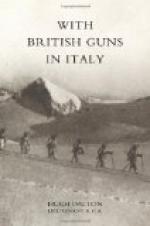[Footnote 1: A “Number One” is the Sergeant or other N.C.O. in charge of a gun and its detachment when in action. A “B.C.A.” (or Battery Commander’s Assistant) assists the officer on duty in the Command Post in locating points on the map, in making numerical calculations, and in other miscellaneous duties.]
Seventeen months later, only the Major, Leary and myself, out of the officers in the Battery when I joined, still remained with it, and death, wounds, sickness, promotion and commissions from the ranks had taken from us many of our best N.C.O.’s and men. But through all the varied experiences of those long months, there had been a continuity of tradition and an unchanging spirit. We were still, for me and for many, the First British Battery in Italy.
PART III
THE ITALIAN SUMMER OFFENSIVE, 1917
CHAPTER XIV
THE OFFENSIVE OPENS
On the 18th of August I got up at half-past four in the morning. There was a mist in the air, which cleared away as the day grew warmer. The big bombardment in what the journalists called the Twelfth Battle of the Isonzo began at six o’clock and went on continuously all day. Once the thing was started, I had little to do except to change occasionally the rate of fire,—“lento,” “normale,” “vivace,” “celere” and “double vivace” by turns. The first part of the day I was in charge of the Right Section of the Battery and sat most of the time on a wooden bench at a table under a tarpaulin among the acacias. By my side sat a telephonist in communication with the Battery Command Post, some four hundred yards away to the left, beyond the Left Section. My only other apparatus was a megaphone, a notebook and pencil, and a pipe. Occasionally I would go and stand by one of the guns, to check the gun-laying and to see that the guns were recoiling and coming up again without undue violence. One had also to guard against a dust cloud being raised by the blast of the guns, thus giving away our position to the enemy. To prevent this, we formed a chain of men every half hour to pass water-buckets from hand to hand, from the river just behind us down the sunken road, to lay the dust in and around the gun pits. But under an Italian August sun the ground soon grew parched and dusty again.




